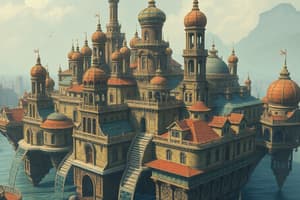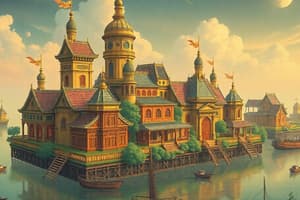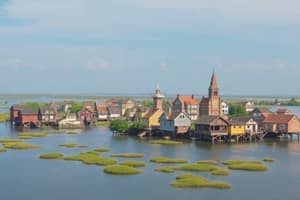Podcast
Questions and Answers
What is the primary motivation behind Japan's N-Ark proposing the construction of a floating city?
What is the primary motivation behind Japan's N-Ark proposing the construction of a floating city?
- To develop a novel design for maritime cities that can accommodate a large number of tourists.
- To create a self-sufficient community focused on advanced healthcare and drug discovery.
- To establish a new hub for space tourism and rocket launches.
- To mitigate the risks associated with escalating sea levels caused by global warming. (correct)
What design feature of N-Ark's Dogen City is specifically intended to protect inhabitants from tsunamis?
What design feature of N-Ark's Dogen City is specifically intended to protect inhabitants from tsunamis?
- The integration of advanced healthcare facilities on the top layer.
- The city's two-layer design with an undersea data center.
- The city's circular shape with a diameter of approximately 1 mile. (correct)
- The dedicated area for launching and landing rockets.
How does Dogen City plan to achieve food self-sufficiency for its residents?
How does Dogen City plan to achieve food self-sufficiency for its residents?
- By utilizing traditional farming methods on the floating structure.
- By relying on advanced healthcare facilities to reduce dietary needs.
- By importing food supplies from other countries.
- By implementing new farming technology that uses seawater to produce food. (correct)
Besides N-Ark's Dogen City, which other city has unveiled plans for a sustainable maritime metropolis?
Besides N-Ark's Dogen City, which other city has unveiled plans for a sustainable maritime metropolis?
What distinguishes Amsterdam's Schoonship neighborhood from the floating city projects proposed by N-Ark and Busan?
What distinguishes Amsterdam's Schoonship neighborhood from the floating city projects proposed by N-Ark and Busan?
What is the purpose of the undersea layer in N-Ark's Dogen City design?
What is the purpose of the undersea layer in N-Ark's Dogen City design?
Assuming N-Ark's Dogen City successfully launches in 2030 as planned, and given its capacity for 10,000 residents and 40,000 visitors, what percentage of its maximum capacity is reached when the city is at full residency but has no visitors?
Assuming N-Ark's Dogen City successfully launches in 2030 as planned, and given its capacity for 10,000 residents and 40,000 visitors, what percentage of its maximum capacity is reached when the city is at full residency but has no visitors?
Considering the multifaceted challenges of constructing a floating city like Dogen City—including technological innovation, environmental impact, economic feasibility, and social adaptation—which factor, if compromised, would most critically undermine the long-term sustainability and viability of the project, potentially leading to its failure?
Considering the multifaceted challenges of constructing a floating city like Dogen City—including technological innovation, environmental impact, economic feasibility, and social adaptation—which factor, if compromised, would most critically undermine the long-term sustainability and viability of the project, potentially leading to its failure?
Flashcards
Floating City
Floating City
A city designed to float on water, addressing rising sea levels.
Rising Sea Levels
Rising Sea Levels
Rising water levels are caused by global warming, threatening coastal areas.
Dogen City
Dogen City
A project by Japan's N-Ark to build a floating city.
Circular City Shape
Circular City Shape
Signup and view all the flashcards
Dogen City Top Layer
Dogen City Top Layer
Signup and view all the flashcards
Dogen City Undersea Layer
Dogen City Undersea Layer
Signup and view all the flashcards
Seawater Farming
Seawater Farming
Signup and view all the flashcards
Schoonship
Schoonship
Signup and view all the flashcards
Study Notes
- Rising sea levels are increasing due to global warming, threatening coastal communities worldwide.
- By 2050, approximately 300 million coastal residents may experience annual flooding.
- N-Ark, a Japanese company, has proposed an innovative floating city concept to combat climate change effects.
Dogen City
- The proposed city will measure roughly 1 mile (1.58 km) in diameter and about 2.5 miles (4 km) in circumference.
- The circular design aims at protecting against tsunamis.
- This city will have a two-layer structure:
- A self-sufficient maritime city on the top layer.
- An undersea layer houses a sea-cooled data center supporting city management, healthcare, and drug discovery.
- Dogen City will accommodate 10,000 residents and up to 40,000 visitors.
- The city aims to be self-sufficient, featuring food production facilities, schools, hospitals, sports areas, offices, and parks.
- It will use new farming technology to produce up to 7,000 tons of food annually using seawater.
- State-of-the-art healthcare assessments and medical care will be available to residents and visitors.
- The plan includes an area for rocket launches and landings for space tourism.
- The target completion date for Dogen City is set for 2030.
- Specifics like location and cost are not yet disclosed.
Other Floating City Projects
- Busan, South Korea, announced similar plans in 2022 for a sustainable maritime metropolis.
- Busan's floating city seeks at housing up to 100,000 people.
Schoonship, Netherlands
- The Netherlands has a thriving floating community called Schoonship since 2021.
- Schoonship consists of 46 homes on 30 water plots, housing around 100 residents.
- It serves as a small-scale model for self-sufficient, eco-friendly floating cities.
Studying That Suits You
Use AI to generate personalized quizzes and flashcards to suit your learning preferences.




